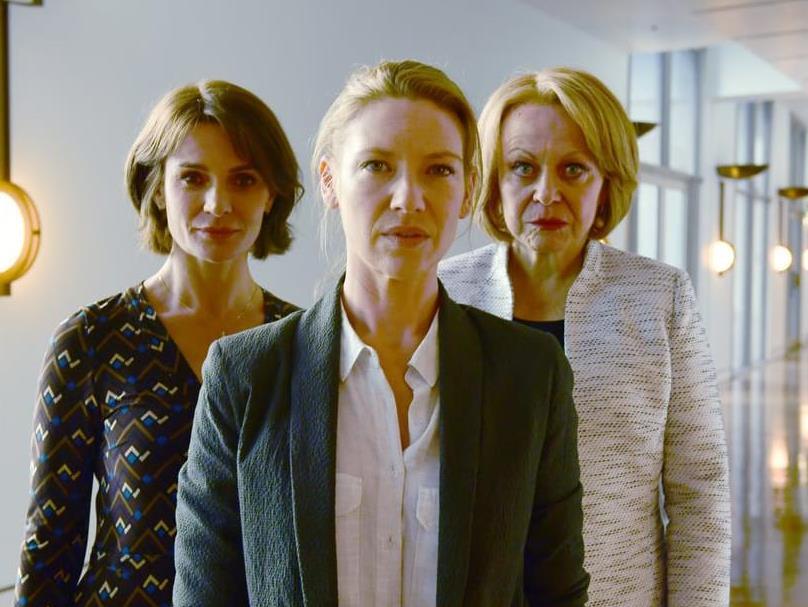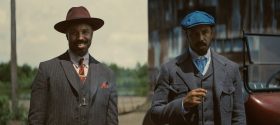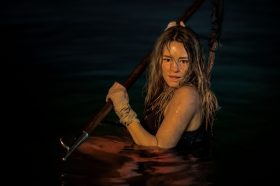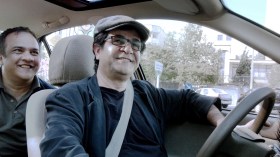“There’s a difference between truth and plausibility” Catriona Bailey (Jacki Weaver) told her ministerial colleague Mal Paxton (Dan Wyllie) before his quiet resignation (for family reasons, inevitably) at the end of the first season of Secret City. Bailey was the one caught colluding with China, but Paxton was the one compromised. Disgraced. Too muddied himself to sling any at her.
Bailey had also seen off the only other significant threat to her sovereign authority: Canberra bubble journalist Harriet Dunkley (Anna Torv). Having fallen foul of draconian national security legislation engineered by Bailey, Dunkley ended the 2016 season sacked, discredited and imprisoned. But alive… just! (She’d been shot at – while rowing on Lake Burley Griffin – had her wrists slashed in a bogus bathtub suicide, and survived a strangulation attempt by her spook lover. All in a day’s work for a star of the parliamentary press gallery!)
The solid first series of Secret City, filmed in Parliament house and locations across Canberra and Sydney, aired in 2016 and was picked up by Netflix two years later. It was inspired by the best-selling novels The Marmalade Files and The Mandarin Code, written by political journos Chris Uhlmann and Steve Lewis, who join this series as consultants.
The creators of the six-part second season of Secret City, entitled Under the Eagle, have taken Bailey’s truth-versus-plausibility line to heart too. Under the Eagle cautiously backs away from the cartooned excesses of the first season. What’s plausible – and actually happening happening in the world – doesn’t necessarily strike the casual viewer as truthful. In a world of Five Eyes and PRISM, where the UK’s GCHQ does the Pentagon’s dirty work and WikiLeaks willingly beds down with the Kremlin, the truth is so perverse – so much stranger than fiction – it would scarcely be believed.
So, instead of a paranoia-driven and tech-driven narrative, Under the Eagle has a carefully crafted, rock-solid, spy-thriller plot. It’s powerful because it’s believable.
Now head of the Home Affairs super ministry, with sweeping and unchallenged powers, Bailey is untouchable. Dunkley, out on parole after two years in the slammer, wants nothing more than to leave the nation’s capital. But, as Tony Abbott so eloquently put it, shit happens. Even to the archest of arch villains. And the super minister has more than her fair share of enemies and rivals, at home and abroad.
If you haven’t already seen the first episode of Under the Eagle, which premiered last night, you’re in for a treat. And a shock. Seriously… stick your fingers in your ears and shut your eyes tight until you watch it. Do not, under any circumstances, read any other review or recap.
You could hardly construct a more topical plot. Under the Eagle has Pakistani border incursions, draconian suppression orders, a tottering government trying to tough it out without cross-bench support, and surveillance (not to mention UAVs) galore.
Under the Eagle begins with an explosion in the outer northern suburbs of Adelaide. Inevitably, grandstanding politicians try to blame one another for infrastructure failures and gas leaks. They then seek to capitalise on possible terrorist links. But are the dead “collateral damage” or – god forbid – the victims of friendly fire?
Narrative authenticity (relatively speaking) has an impact on both sides of D.O.P. Mark Wareham’s camera. With secure and clearly defined through-lines, cast members of Under the Eagle revel in their roles, none more so than Danielle Cormack as the media-savvy independent MP for Wakefield in South Australia, Karen Koutoufides. A populist cross-bencher with huge momentum and increasing clout, ‘KK’ develops a Jacqui Lambie-esque twang whenever she finds she has ascendancy over government ministers and, especially, their lackeys. (Marcus Graham is terrific as Bailey’s principle private lickspittle, Andrew ‘Griff’ Griffiths. Griff – who used to be Harri’s managing editor at The Daily Nation – does what he has to without ever seeming to enjoy it.)
Aside from some phoney and horribly cliched bit-part American operatives – ambassadorial, governmental and military-industrial – the main players in this drama are nuanced, three-dimensional and entirely convincing, even when their back stories are ludicrously far-fetched.
Harri’s former cellmate Mina Almasi, a middle eastern refugee and adoring mother who keeps handguns and wads of cash locked up in her garage, seems perfectly reasonable as rendered by Louisa Mignone of Rake and Ms Fisher’s Modern Murder Mysteries fame.
Ditto Laura Gordon, a believably psycho drone pilot gone AWOL. (Even if the idea that someone so patently unstable, mentally, would be piloting military kill missions strains credulity.) Rob Collins is unimpeachable as the trusted squadie home from Waziristan.
But it’s the shag-haired Torv (looking more like Emma Booth than ever) who carries the show with her expressions alone: sly, pained, drained and knowing. She seems to know as much about what’s going as the writers, but we ‘buy’ her smart mouth and preternaturally quick wit. Willingly.
When things start getting complicated at the start of the fourth episode, you’ll need to pay careful attention. But, by then, you’ll be along for the slam-cam death-defying ride.
Chris Boyd
Secret City: Under the Eagle Six episodes. Screening weekly (and streaming) on Fox Showcase in Australia, and on Netflix internationally from 6 March.
Created by Matt Cameron and Belinda Chayko. A Matchbox Pictures production for Foxtel. Written by Matt Cameron (showrunner), Belinda Chayko, Angela Betzien and Elise McCredie. Directed by Tony Krawitz and Daniel Nettheim.
5 stars ★★★★★Actors:
Director:
Format:
Country:
Release:





